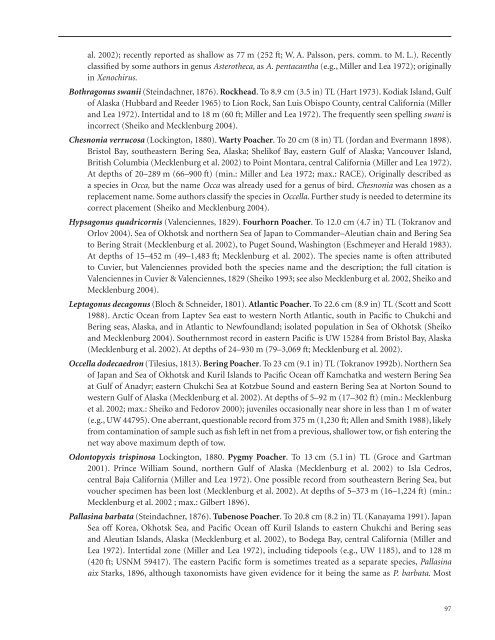Untitled - Alaska Resources Library
Untitled - Alaska Resources Library
Untitled - Alaska Resources Library
Create successful ePaper yourself
Turn your PDF publications into a flip-book with our unique Google optimized e-Paper software.
al. 2002); recently reported as shallow as 77 m (252 ft; W. A. Palsson, pers. comm. to M. L.). Recently<br />
classified by some authors in genus Asterotheca, as A. pentacantha (e.g., Miller and Lea 1972); originally<br />
in Xenochirus.<br />
Bothragonus swanii (Steindachner, 1876). Rockhead. To 8.9 cm (3.5 in) TL (Hart 1973). Kodiak Island, Gulf<br />
of <strong>Alaska</strong> (Hubbard and Reeder 1965) to Lion Rock, San Luis Obispo County, central California (Miller<br />
and Lea 1972). Intertidal and to 18 m (60 ft; Miller and Lea 1972). The frequently seen spelling swani is<br />
incorrect (Sheiko and Mecklenburg 2004).<br />
Chesnonia verrucosa (Lockington, 1880). Warty Poacher. To 20 cm (8 in) TL (Jordan and Evermann 1898).<br />
Bristol Bay, southeastern Bering Sea, <strong>Alaska</strong>; Shelikof Bay, eastern Gulf of <strong>Alaska</strong>; Vancouver Island,<br />
British Columbia (Mecklenburg et al. 2002) to Point Montara, central California (Miller and Lea 1972).<br />
At depths of 20–289 m (66–900 ft) (min.: Miller and Lea 1972; max.: RACE). Originally described as<br />
a species in Occa, but the name Occa was already used for a genus of bird. Chesnonia was chosen as a<br />
replacement name. Some authors classify the species in Occella. Further study is needed to determine its<br />
correct placement (Sheiko and Mecklenburg 2004).<br />
Hypsagonus quadricornis (Valenciennes, 1829). Fourhorn Poacher. To 12.0 cm (4.7 in) TL (Tokranov and<br />
Orlov 2004). Sea of Okhotsk and northern Sea of Japan to Commander–Aleutian chain and Bering Sea<br />
to Bering Strait (Mecklenburg et al. 2002), to Puget Sound, Washington (Eschmeyer and Herald 1983).<br />
At depths of 15–452 m (49–1,483 ft; Mecklenburg et al. 2002). The species name is often attributed<br />
to Cuvier, but Valenciennes provided both the species name and the description; the full citation is<br />
Valenciennes in Cuvier & Valenciennes, 1829 (Sheiko 1993; see also Mecklenburg et al. 2002, Sheiko and<br />
Mecklenburg 2004).<br />
Leptagonus decagonus (Bloch & Schneider, 1801). Atlantic Poacher. To 22.6 cm (8.9 in) TL (Scott and Scott<br />
1988). Arctic Ocean from Laptev Sea east to western North Atlantic, south in Pacific to Chukchi and<br />
Bering seas, <strong>Alaska</strong>, and in Atlantic to Newfoundland; isolated population in Sea of Okhotsk (Sheiko<br />
and Mecklenburg 2004). Southernmost record in eastern Pacific is UW 15284 from Bristol Bay, <strong>Alaska</strong><br />
(Mecklenburg et al. 2002). At depths of 24–930 m (79–3,069 ft; Mecklenburg et al. 2002).<br />
Occella dodecaedron (Tilesius, 1813). Bering Poacher. To 23 cm (9.1 in) TL (Tokranov 1992b). Northern Sea<br />
of Japan and Sea of Okhotsk and Kuril Islands to Pacific Ocean off Kamchatka and western Bering Sea<br />
at Gulf of Anadyr; eastern Chukchi Sea at Kotzbue Sound and eastern Bering Sea at Norton Sound to<br />
western Gulf of <strong>Alaska</strong> (Mecklenburg et al. 2002). At depths of 5–92 m (17–302 ft) (min.: Mecklenburg<br />
et al. 2002; max.: Sheiko and Fedorov 2000); juveniles occasionally near shore in less than 1 m of water<br />
(e.g., UW 44795). One aberrant, questionable record from 375 m (1,230 ft; Allen and Smith 1988), likely<br />
from contamination of sample such as fish left in net from a previous, shallower tow, or fish entering the<br />
net way above maximum depth of tow.<br />
Odontopyxis trispinosa Lockington, 1880. Pygmy Poacher. To 13 cm (5.1 in) TL (Groce and Gartman<br />
2001). Prince William Sound, northern Gulf of <strong>Alaska</strong> (Mecklenburg et al. 2002) to Isla Cedros,<br />
central Baja California (Miller and Lea 1972). One possible record from southeastern Bering Sea, but<br />
voucher specimen has been lost (Mecklenburg et al. 2002). At depths of 5–373 m (16–1,224 ft) (min.:<br />
Mecklenburg et al. 2002 ; max.: Gilbert 1896).<br />
Pallasina barbata (Steindachner, 1876). Tubenose Poacher. To 20.8 cm (8.2 in) TL (Kanayama 1991). Japan<br />
Sea off Korea, Okhotsk Sea, and Pacific Ocean off Kuril Islands to eastern Chukchi and Bering seas<br />
and Aleutian Islands, <strong>Alaska</strong> (Mecklenburg et al. 2002), to Bodega Bay, central California (Miller and<br />
Lea 1972). Intertidal zone (Miller and Lea 1972), including tidepools (e.g., UW 1185), and to 128 m<br />
(420 ft; USNM 59417). The eastern Pacific form is sometimes treated as a separate species, Pallasina<br />
aix Starks, 1896, although taxonomists have given evidence for it being the same as P. barbata. Most<br />
97
















